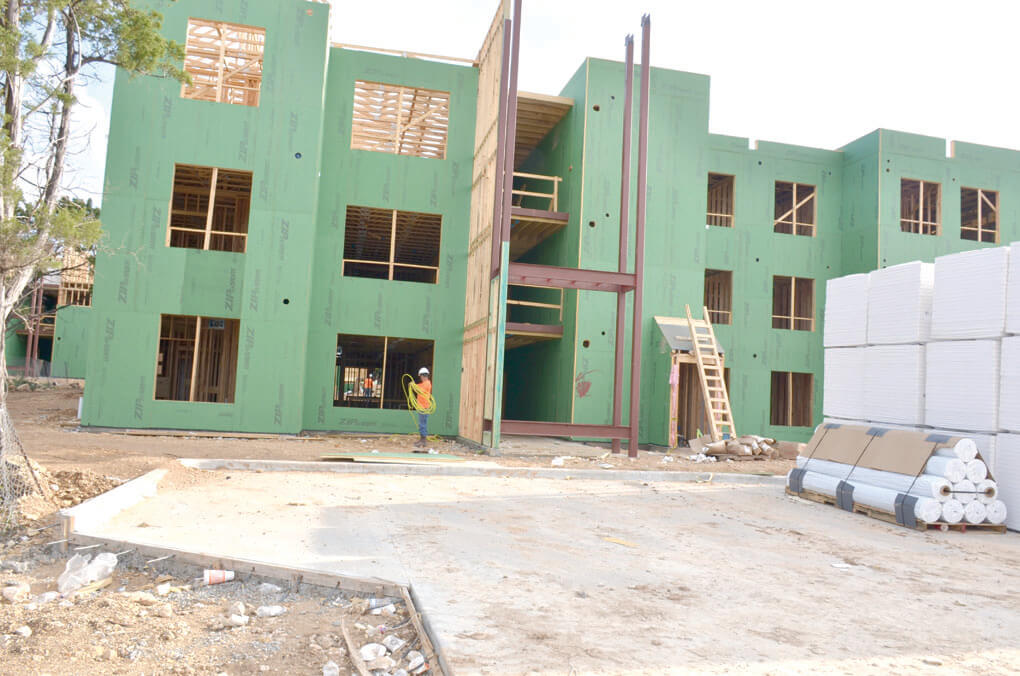
Construction of Cardinal Points, off of Four Points Drive near River Place Boulevard, is underway and will have 120 units. Construction workers were busy at the site on Monday.
By CASSIE MCKEE
Four Points News
With Leander ISD adding approximately 1,000 new students per year, making it one of the fastest-growing school districts in the state, school board trustees may have to start taking a closer look at the impact subsidized apartment developments could have on existing schools.
Two new subsidized developments are planned to be completed in the next two years within Leander ISD. In Four Points, Cardinal Point is currently under construction and will have 120 units. The Tuckaway Apartments is another 250-unit development expected to open this year in Cedar Park. There are six subsidized developments already located throughout the district.
“When one comes in, others tend to follow because it sets a precedent,” LISD Superintendent Dan Troxell said during an October meeting of the school board.
Troxell said some school districts in the state have made the decision to oppose subsidized developments because they tend to have higher percentages of students per unit, which can force school districts to have to pass bonds to build additional schools. He said that Katy ISD is one such district that now opposes all subsidized housing after having to build two new elementary schools to accommodate two subsidized developments a number of years ago.
Dr. Stacey Tepera, data manager for Population and Survey Analytics, the firm which compiles annual demographic data for LISD, said it’s not uncommon for school districts to have to build additional schools to accommodate new subsidized developments.
“Many districts are concerned when these complexes are built because it puts a strain on one specific school,” Tepera said.
The reason subsidized apartments are different than typical market-rent apartments is that they tend to have a higher number of students per unit, she said. While most market-rent apartments in areas like LISD would have an average of .25 to .3 students per unit, subsidized apartments can have as many as one to 1.25 students per unit.
“If a complex has 200 units and they have one student per unit, that’s a ballpark of 100 elementary students,” Tepera said. “If a school is almost at capacity and 100 new students are going to be moving into the school, that has a really big impact.”
While market-rate apartments tend to have a wider demographic such as college students and young professionals, subsidized apartments are income restricted and generally targeted toward helping families.
“It’s designed to help families that have kids that have low income,” Tepera said.
She cited a recent 2015 Supreme Court decision that changed the criteria by which subsidized applications are approved. The fair-housing case was prompted by the way that the Texas Department of Housing and Community Affairs allocated tax credits for affordable housing.
The formula, claimed the nonprofit that sued the agency, effectively guaranteed that affordable housing in Dallas was concentrated in poor, inner-city minority neighborhoods, and was hard to find in the city’s white suburbs. As a result, the lawsuit argued, the housing agency denied low-income minorities the chance to live in neighborhoods with better schools and greater opportunity, perpetuating decades-old patterns of segregation.
The Supreme Court, in a 5-4 decision, ruled that cases like this can be brought under the Fair Housing Act, even if the officials who wrote that formula didn’t intend to discriminate.
“That’s another reason that Leander ISD has a potential to see a greater number of applications for tax credit apartments,” Tepera said.
While apartments such as Cardinal Point did draw opposition from local elected leaders such as former city council member Don Zimmerman, Leander school board officials have stayed neutral on the issue.
Former LISD spokesperson Veronica Sopher said the school board has not officially opposed any subsidized housing developments in the last seven years that she was with the district.
“I don’t have any knowledge of us ever opposing something like that in the past,” Sopher said several weeks ago.
She said the district has already factored in student growth from developments such as Cardinal Point because district officials are in constant communication with developers to keep up to date on housing projects. The district also receives updated demographic data every year.
“A project may not come about for five or six years but it doesn’t mean we’re not aware of it,” Sopher said. “We already take into account future growth. We plan years out in advance. Our demographer is able to report to us every October and give us different scenarios.”
The most recent demographer report showed that no new schools are projected to be needed in the Four Points area, as the majority of new growth is happening in Leander and the northern part of the district.

